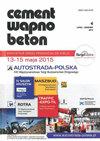废骨料生产碱活化碾压混凝土的性能研究
IF 0.6
4区 工程技术
Q4 CONSTRUCTION & BUILDING TECHNOLOGY
引用次数: 1
摘要
水泥生产过程中的能源消耗和二氧化碳释放要求寻找替代建筑材料。人们越来越需要更环保、更经济、更耐用和高强度的材料。对建筑废料回收的研究有助于满足这一需求。在这项研究中,利用已知的材料和技术生产了一种允许废物再利用的新材料。以再生粗集料为原料制备碱活化碾压混凝土,并对其力学性能进行了研究。在这项实验研究中,目标是生产一种由废物或副产品组成的替代建筑材料。用水玻璃[Na2SiO3]和10 M氢氧化钠[NaOH]溶液对磨碎的矿渣[GGBFS]进行活化。在激活剂溶液中,Na2SiO3 / NaOH比为2.5。从碾压混凝土(RCC)废料中获得粗集料,在不使用任何水泥的情况下生产出一种环保材料。由于与传统混凝土相比,碾压混凝土具有非常干燥的稠度,因此活化剂的使用量很低,从而提供了环境和经济效益。测定了立方体碾压混凝土试件在7天和28天时的抗压强度。采用本研究设计的配合比,发现碱活化rcc的抗压强度高于高水泥掺量的碾压波特兰水泥混凝土。测定了碱活化rcc的单位质量、总吸水率、超声脉冲速度(UPV)和弹性模量。本文章由计算机程序翻译,如有差异,请以英文原文为准。
Properties of alkali-activated roller compacted concretes produced from waste aggregates
The energy consumption and the release of carbon dioxide during cement production require the search for alternative building materials. There is an increasing need for more environmentally friendly, more economical, durable and high-strength materials. Studies on recycling of waste materials in construction contribute to meeting this need. In this study, a new material that allows reuse of wastes was produced using known materials and techniques. Alkali-activated roller compacted concrete [AARCC] was produced with recycled coarse aggregates and the mechanical properties of this material were investigated. In this experimental study, the objective was to produce an alternative construction material composed of waste or by-products. Ground granulated blast furnace slag [GGBFS] was activated with a sodium silicate [Na2SiO3] and 10 M sodium hydroxide [NaOH] solution. The Na2SiO3 / NaOH ratio was 2.5 in the activator solution. The coarse aggregates were obtained from roller compacted concrete (RCC) wastes and an environmentally friendly material was produced without using any cement. As a roller compacted concrete is produced with a very dry consistency compared to conventional concrete, the amount of activator used is low, which provides environmental and economic benefits. The compressive strengths of the cube RCC specimens were determined at the ages of 7 and 28 days. Using the mix proportions designed in this study, it was found that the compressive strengths of alkali-activated RCCs were higher than roller compacted Portland cement concrete having high dosage of cement. Unit mass, total water absorption, ultrasonic pulse velocity [UPV], and modulus of elasticity of alkali-activated RCCs were also determined.
求助全文
通过发布文献求助,成功后即可免费获取论文全文。
去求助
来源期刊

Cement Wapno Beton
CONSTRUCTION & BUILDING TECHNOLOGY-MATERIALS SCIENCE, COMPOSITES
CiteScore
1.30
自引率
28.60%
发文量
0
审稿时长
>12 weeks
期刊介绍:
The Publisher of the scientific bimonthly of international circulation, entitled "Cement-Wapno-Beton" ["Cement-Lime-Concrete"], is the Fundacja Cement, Wapno, Beton [Foundation Cement, Lime, Concrete]. The periodical is dedicated to the issues concerning mineral setting materials and concrete. It is concerned with the publication of academic and research works from the field of chemistry and technology of building setting materials and concrete
 求助内容:
求助内容: 应助结果提醒方式:
应助结果提醒方式:


